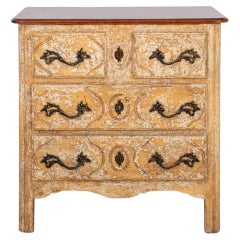Milton Spidell
Recent Sales
Late 20th Century Louis XV Commodes and Chests of Drawers
Metal
A Close Look at louis-xv Furniture
The style of 18th-century French furniture was guided by the court. When Louis XV, who reigned from 1715–74, focused royal life on the smaller salons of Versailles rather than its grand chambers, it transformed the aesthetics away from the imposing and angular furniture that characterized the style of Louis XIV. A broader focus on comfort and more delicate forms define antique Louis XV furniture, with nature-inspired carvings, wood inlays, curved cabriole legs, asymmetrical shapes and rounded oval seat backs. The furnishings changed throughout the king’s life, as he ascended to the throne as a child and then grew to establish his own tastes.
Pieces like the bergère, an upholstered armchair with a wide cushion that fit the flowing dresses in fashion at the time, reflected this more informal court. Introduced at the start of Louis XV’s reign, bergère chairs in this style were deeper and broader than other chairs of the period.
Louis XV tapestries and carpets tended to be floral and colorful, and design elements were borrowed from Asia. Dutch-born cabinetmaker Bernard van Risenburgh brought lacquer techniques influenced by Japan and China into his luxuriously made furniture. Along with its fine details, the furniture of the era also featured new innovations including mechanical devices. Jean François Oeben, a royal cabinetmaker, created such intricate pieces as a mechanical table for Madame de Pompadour, Louis XV’s mistress. It involved a sliding top and a writing surface that extended from its marquetry panels.
During the later years of Louis XV’s reign, there was a shift from the ostentatious rocaille style, part of the exuberantly decorative Rococo movement in Europe for which designers such as Nicolas Pineau and Juste-Aurèle Meissonier are known. The style under Louis XVI would return to boxier forms, but with a neoclassical touch inspired by the ancient world.
Find antique Louis XV bedroom furniture, seating, tables and decorative objects on 1stDibs.
Finding the Right commodes-chests-of-drawers for You
Is it a commode or a chest of drawers?
Commode is the French term for a low chest of drawers, but it is also sometimes used to denote a piece with a particularly intricate design. The commode dates to circa 1700 France, where it was used as an alternative to a taller cabinet piece so as to not obscure paneled, mirrored or tapestried walls. Coffers, or chests, which were large wooden boxes with hinged lids and sometimes stood on ball feet, preceded chests of drawers, a fashionable cabinet furnishing that garnered acclaim for its obvious storage potential and versatility.
As time passed, French and British furniture makers led the way in the production of chests of drawers, and features like the integration of bronze and ornamental pulls became commonplace. Antique French commodes in the Louis XV style were sometimes crafted in mahogany or walnut, while an Italian marble top added a sophisticated decorative flourish. This specific type of case piece grew in popularity in the years that followed.
So, what makes a chest of drawers different from a common dresser? Dressers are short, and chests of drawers are overall taller pieces of furniture that typically do not have room on the top for a mirror as most dressers do. Tallboys and highboys are variations of the dresser form. Some chests of drawers have one column of four to six long drawers or three long drawers in their bottom section that are topped by a cluster of small side-by-side drawers on the top. To further complicate things, we sometimes refer to particularly short chests of drawers as nightstands.
Even though chests of drawers are commonly thought of as bedroom furniture to store clothing, these are adaptable pieces. A chest of drawers can house important documents — think of your walnut Art Deco commode as an upgrade to your filing cabinet. Nestle your chest near your home’s front door to store coats and other outerwear, while the top can be a place to drop your handbag. Add some flair to your kitchen, where this lovable case piece can hold pots, pans and even cookbooks.
When shopping for the right chest of drawers for your home, there are a few key things to consider: What will you be storing in it? How big a chest will you need?
Speaking of size, don’t dream too big. If your space is on the smaller side, a more streamlined vintage mid-century modern chest of drawers, perhaps one designed by Paul McCobb or T.H. Robsjohn-Gibbings, may best suit your needs.
At 1stDibs, we make it easy to add style and storage to your home. Browse our collection of antique and vintage commodes and chests of drawers today.
